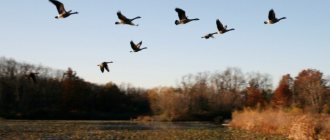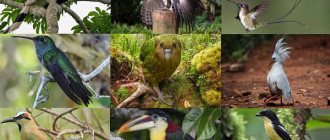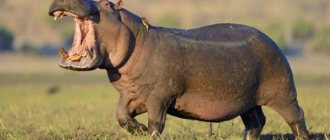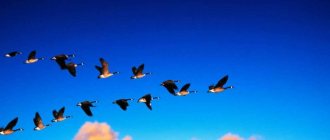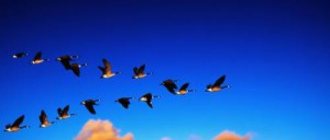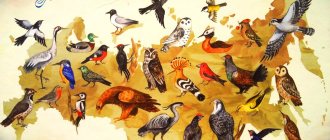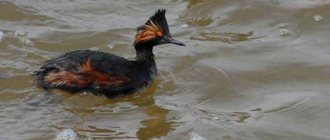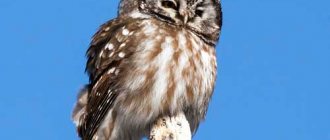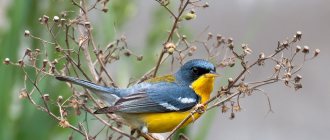Some of the most amazing warm-blooded creatures that can survive severe frosts without loss are wintering birds. Although in the cold season the process of searching for food becomes more difficult, and many of their brethren fly to warm countries, these birds do not leave their native places. Of course, this way of life allows them to more easily adapt to changing environmental conditions, but this does not mean that they do not need human help.
What birds are wintering?
Based on sedentary behavior, birds are divided into 4 main categories.
Migratory, they are characterized by the habit of changing their habitat in accordance with the changing seasons. They prefer to live near ponds and fields, but sometimes they can be found in forests or one of the populated areas. The basis of the diet of these birds is insects and animal meat. Migratory birds (cranes, loons, geese, storks) prefer to live and travel in flocks.
Nomadic birds (bullfinches, siskins, woodpeckers) do not have a permanent “home”. They regularly change their habitats, looking for areas where there will be more food.
Semi-sedentary ones live in the nest all year. They begin to leave it only after the appearance of chicks that need food. This category includes buntings, crows, black grouse, magpies, wood grouse and hazel grouse.
Sedentary ones live in one area and do not even change their nest. The resident species are owls, snowy owls, eagle owls and nuthatches.
In fact, when talking about which birds remain for the winter, we should keep in mind all the groups described, except for the first. Even nomadic individuals rarely leave Russia.
Bullfinches
These birds are found in coniferous and mixed forests, since the basis of their diet is the seeds of spruce, pine, berries, mainly rowan, and tree buds. In appearance they are slightly larger than a sparrow, but their color is amazing.
It is quite possible to catch a bullfinch and tame it. The birds get used to the cages, over time even starting to sing simple melodies to their owner.
Which bird doesn't fly south?
The most famous and common wintering bird species are listed below.
The sparrow is noisy, flocking, but inconspicuous in appearance. Boldly flies up to the feeders. Saves crops from insects.
The tit moves quickly, is not afraid to approach the feeders, but behaves more modestly than a sparrow. In summer, tits consume an amount of food equal to their weight.
The chickadee is related to the tit. Builds nests in hollows.
The crow is rarely found in the western territories of the Russian Federation. Very smart, omnivorous (often feeds on carrion).
The pigeon settles equally easily both among rocks and among human buildings. He has a nodding gait, which allows him to better examine objects of interest to him.
In summer, the woodpecker eats insects that it has to extract from under the tree bark. In winter, he switches to plant foods (nuts, as well as pine and spruce seeds).
Magpie is endowed with great intellectual and emotional capabilities. Able to recognize herself in a mirror image.
Who else winters in Russia
The owl (more than 200 species) has acute vision and hearing, due to which it leads a nocturnal lifestyle.
Jackdaws often live in flocks that include not only other jackdaws, but also crows and rooks.
The nuthatch is a small bird that can quickly climb trees. In the warm season, it scatters nuts and seeds over the unevenness of the bark, making reserves for the winter.
Bullfinch - it is interesting that the bright red breast distinguishes only the males of this species, the females are paler. In summer, the birds live in wooded areas and are difficult to spot. However, as soon as it gets cold outside, and due to a lack of food, bullfinches begin to reach out to human habitation.
In winter, the waxwing settles in cities or moves to more southern regions, feeding on rowan berries and other fruits. Can imitate many sounds (for example, a dog barking).
The jay is large in size, which does not prevent it from emptying feeders designed for sparrows and titmice. In summer it is difficult to find her, but in winter she increasingly appears near human houses.
The wood wren is a close relative of the sparrow. It is tiny in size and weighs only 5-7 g.
In total, about 70 species of birds remain in Russia for the winter, including predatory hawks and falcons, as well as pheasants, hazel grouse and black grouse.
Who doesn't stay for the winter?
As mentioned above, only migratory birds do not stay for the winter.
The nightingale is an outwardly inconspicuous, heat-loving bird. During wintering, it moves to East Africa (Kenya, Ethiopia).
The swallow prefers to live in rocky areas. With the onset of autumn, the swallow goes to Tropical Asia or South Africa.
The siskin is a migratory bird, but does not fly too far for the winter: to Southern Europe, the Caucasus or Kazakhstan. The plumage is gray-green, the behavior is cautious.
The rook is similar to a crow, but has a yellow-gray beak. It is a conditionally migratory bird, as it often chooses central Russia or Ukraine for wintering.
The goldfinch is a close relative of the siskin. It has variegated plumage. In Europe, this bird can live all year round, but in Russia it stays only for the summer.
Wagtail The bird was named for its characteristic walking style. The wagtail winters in South Asia or Europe, as well as in East Africa.
Interestingly, there are many folk superstitions associated with birds. For example, they say about a crow that with its beak it indicates where the wind will come from. And if she hides it, then she needs to wait for the cold weather. The morning squeak of titmice speaks about the same thing.
And the harbingers of a thaw are the chirping sparrows and any other birds perched on the treetops.
List of migratory birds
There is also a wide range of warm-blooded vertebrate animals capable of flight that leave warm regions with the onset of cold weather. Most of them are familiar to everyone, or many have seen them at least in a picture.
Stately rooks
If you read the description of this bird, it will seem that we are talking about a raven. Indeed, these birds from the corvid class are very similar to each other. But, unlike their relatives, rooks are migratory birds. In ancient times, it was the arriving rooks that symbolized the imminent arrival of spring. They fly home the very first, as soon as a small thaw appears in the snow. An interesting fact about rooks is that the birds make themselves swings from branches to relax. They can swing on a homemade swing for a long time. Rooks are unpretentious in food, but despite this, they lead a migratory lifestyle.
Cute swallows
“A swallow flies towards us with spring in the canopy” - these lines from Pleshcheev’s children’s poem were not written in vain, since this bird is another messenger of the coming spring. But swallows are still conditionally migratory birds, it all depends on what climate surrounds them in the place of settlement. From Russia, they prefer to leave their homes during cold weather, since the air in winter is too cold for small birds. Swallows differ in their behavior:
- are not afraid of people;
- They build their nests directly on houses.
If this happens, then it is considered a good omen to have a swallow’s nest under your window. But swallows are also very beautiful and fast. Their flight speed is about 120 km/h. In the summer you can observe a very funny picture: when a huge flock of chicks learns to fly, the entire sky, not high from the ground, is strewn with black dots, which every now and then fall to the ground or wires in order to rest.
Song larks
One of the most songbirds. Their trills have been spreading since the end of March. Birds are so carried away by their singing that they forget to build a nest on time, and begin this activity much later than their fellow birds. Larks are unpretentious when it comes to food, so they eat whatever they can get. It is interesting that larks build their nests in secluded places, but not in trees. Their homes can be found in the thick of bushes, in the grass, even under stones.
Melodious nightingale
Well-known singers. It is rare to meet a person who, at least once in his life, on a quiet summer evening, would not indulge in daydreaming while the nightingale sings. Against the background of the rustling of leaves and the evening sunset, their trills sound even more romantic. Their beautiful voice compensates for their modest appearance, since these birds are small with nondescript coloring . The predominant colors are:
- dark brown;
- grey;
- brown;
- black.
In winter, they fly to more southern regions of the planet.
Unlike their feathered counterparts, nightingales fly home quite late - at the end of May. By the way, the male nightingale entertains the female with his singing while she lays and incubates eggs. They are very secretive and cautious, so you rarely get to see them.
Copycat starlings
Capable of reproducing various sounds, including the meowing of a cat. Looking at the images of the starling, you can understand from its variegated color that it is a joker who fakes the voices of his relatives . Depending on their habitat, they are conditionally migratory. They fly a large number of kilometers to rest in the winter and return to their homeland in the spring.
It happens that the cold has not subsided, but the birds have already returned, then it is very difficult for them, sometimes the weakest die. Residents of warm countries are not at all very fond of starlings for their huge clusters and loud chirping. Due to their large accumulations, they often cause damage to crops and berries. But still, starlings bring more benefits for exterminating pests. People make birdhouses for them, and the birds happily hatch their eggs in them.
Long-legged stork
This is such a curious character that he even became the hero of Bianchi’s story “Who Sings What.” Externally, it is a huge bird that amazes with its majesty. Representatives of this species build large nests on the roofs of houses and water towers. Storks are monogamous and choose a mate for life. In the summer they stay in pairs, and in the winter they gather in large flocks and fly south. The amazing thing is that during the flight the bird even manages to rest a little . The sleep is not long, about 15 minutes, but it is enough to continue the long journey. Upon returning home, they return to their ancestral nests, sometimes the homes are inherited. The stork's main delicacy is frogs, which is why birds choose wetlands as places to live.
How birds live in winter
With the onset of frost, they practically stop flying, since they freeze much faster in flight. Instead, they increasingly sit with their heads ruffled. This way they manage to trap still air between their feathers and keep warm.
In addition, birds can stand on one leg while warming the other. They also gather in flocks, cling to their relatives and hide their beaks under their wings to escape the frost. Capercaillies, black grouse, partridges and hazel grouse bury themselves in the snow for these purposes (this is partly dangerous, since if a hard crust forms they cannot get out).
If one of the birds in the flock finds food or notices danger, it immediately notifies the others. This makes it much easier to survive the winter. However, many birds prepare food supplies in advance, in the summer.
Why you need to feed birds in winter
Feed the birds in winter. Let flocks of people flock to your porch from all over, as if it were home. Their food is not rich. A handful of grain is needed, One handful - And winter will not be scary for them. It’s hard to count how many of them are dying. It’s hard to see. But in our heart there is also warmth for the birds. How can we forget: They could have flown away, But they stayed to spend the winter Together with the people. Teach the birds to your window in the cold, So that we don’t have to welcome spring without songs.
Article on the topic: Telephone conversations with the employer. Techniques for conducting telephone conversations Techniques for conducting telephone conversations during employment
Bird canteen
What do birds eat in the cold?
Now wintering birds often settle in cities, where they can almost always find food, which can be very diverse:
- in sparrows: insects and seeds,
- in rock pigeons: seeds of plants of certain species or grains,
- for bullfinches: only seeds (including berries, the pulp of which they simply discard),
- for eagle owls: small living creatures (or even large prey, which they have to tear with their beaks in order to swallow).
Crows, unlike the above birds, are omnivores, but even in winter it is quite difficult for them to find food. Therefore, in the cold season, birds especially need the help of a person who can feed them:
- fresh and dried fruits,
- crumbs of dried white bread,
- grains,
- cones and nuts,
- lard (tits especially love it).
All these products are easily available and even a small amount of them can save birds from starvation.
How to make a bird feeder
To help wintering birds survive the frosts, it is enough to make several feeders.
A correct feeder is considered to be one in which food regularly appears, while its external shape matters only to the person who makes it.
It is most convenient to immediately make a stable wooden bird feeder that will serve for several years. You can also make it from a plastic bottle or cardboard milk carton. To do this, just cut a few holes in the container, hang it and fill it with food. For additional weight (so that the feeder does not sway from gusts of wind), you can sprinkle several pebbles on the bottom. Even a child can easily cope with this task, who will also find it extremely exciting.
Crossbill
This is a northern bird that usually lives in coniferous forests. The main diet of birds consists of seeds of coniferous cones. They can fly long distances in search of food.
In appearance, the crossbill slightly resembles a sparrow. The main feature of the bird is the structure of its beak: the mandible and mandible are connected and run on opposite sides.
The bird adapts well to frost and low temperatures. They know how to insulate their nests with moss and animal hair. Natural resistance allows eggs to hatch even at sub-zero temperatures.
Watching birds in the winter dining room
Children can not only make feeders themselves, but also watch the birds gathering in this “dining room.” It is especially recommended to pay attention to the following points:
- what kind of birds fly up to the feeder, as well as on what days they appear and at what time,
- how visitors behave towards each other (do they chase neighbors away, do they quarrel),
- which treats are eaten more readily,
- how birds arrive: one at a time or in flocks,
- Do the birds eat directly at the feeder or do they prefer to take food and fly away with it to another branch?
During a walk, you can invite children to independently determine which birds winter in a given area, using their ornithologist’s diary (you need to fill it out before going on a walk, so that they have a clue where to find it).
If you learned something new or you just liked the article, then like, repost and, of course, be sure to leave comments on the topic.
Who flies off first
The species that feed on insects are the first to fly to warmer climes. Swifts already fly south in September, because they fly high and catch insects there. As you know, in such conditions food disappears faster, since it is much colder at altitude. The swift prefers to winter in Africa or in southern India, where there are all conditions for wintering insectivores.
Immediately after the swifts, swallows fly south, passing the sea, the Sahara Desert and stopping in southern Africa. They feed on dragonflies, which they catch on the fly.
These insects die in cold temperatures or hide in shelters. As a result, swallows have nothing to eat, and they have to form flocks and go to more suitable regions. They certainly arrive in their native region in March.
